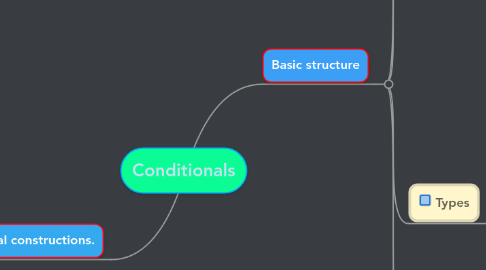
1. Special constructions.
1.1. Type 2
1.1.1. They emphasize improbability.
1.1.2. IF-clause: should + inversion.
1.1.3. MAIN: conditional or imperative.
1.2. If only/ I wish...
2. Basic structure
2.1. They consist of a MAIN CLAUSE and an IF-CLAUSE.
2.2. The IF-clause expresses the condition itself.
2.2.1. It is normally introduced by the conjunction "if"
2.2.2. Other conjunctions may be used:
2.2.2.1. as long as
2.2.2.2. provided/ providing
2.2.2.3. Unless
2.2.2.3.1. Meaning: "if not"
2.2.2.4. in case
2.2.2.4.1. not really a conditional.
2.2.3. The main clause expresses the result of the condition
2.3. Types
2.3.1. Type Zero
2.3.1.1. General or universal conditions
2.3.1.2. IF-clause: if + present simple
2.3.1.3. MAIN: present simple
2.3.2. Type One
2.3.2.1. Probable conditions
2.3.2.2. MAIN: future
2.3.3. Type Three
2.3.3.1. Conditions in the past (impossible)
2.3.3.2. IF-clause: if + past perfetc
2.3.3.3. MAIN: Conditional perfect
2.3.4. Type Two
2.3.4.1. Unreal or improbable
2.3.4.2. IF-clause: if + past simple
2.3.4.3. MAIN: conditional

